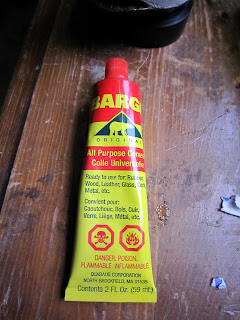 priest, nor will I direct you to your local place or worship. Instead, simply head out to the garage with your damaged sole and let's get to work.
priest, nor will I direct you to your local place or worship. Instead, simply head out to the garage with your damaged sole and let's get to work.The sole in question today is from a pair of The North Face approach/bowling/hipster shoes (not mine, I would never wear faux bowling hipster shoes). The heel area began to peel away from the foam shortly after they were new. Though not terminal, it was annoying for the owner.
The secret to shoe repair is choosing the correct type of adhesive. After all the only thing that is really keeping your sole in place is the glue! Ok, some boot soles are glued, stitched, and sewn in place. I have attempted to repair this sole one epoxy night, however epoxy is not the right type of glue. It is too stiff and does not flex with the rubber and foam. Without the ability to conform is breaks its bond between the two surfaces. Instead Barge Cement should be used when making sole repairs.
First thing to do is to remove as much of the old glue as possible. Next wash the two surfaces that y
 ou are planning to glue. Apply the glue to both sides, allow to dry and "tack" up, 10-15 minutes depending on air temperature. My garage was close to freezing and required about 25 minutes before the glue would tack up. Press the two surfaces firmly against each other, wiping off any excess glue which might ozzzes out.
ou are planning to glue. Apply the glue to both sides, allow to dry and "tack" up, 10-15 minutes depending on air temperature. My garage was close to freezing and required about 25 minutes before the glue would tack up. Press the two surfaces firmly against each other, wiping off any excess glue which might ozzzes out.Here is the trickiest part. Since the two halves do not want to stay together on their own, you need to apply pressure till the cement is fully cured. Holding the soles of these shoes together for 12 hours was not an options. With this type of thing, I usually use clamps or wei
 ghts. However in this application neither of those options would have worked out. The curves surface needed varying degrees of force applied at different angles. The solution: TAPE. I used electrical tape and "tape the hell out of" the sole. Seemed to work out pretty good. I left the shoes in this state for two days before removing the tape and returning them to their owner. I do not think that this was nessary, just happened that way.
ghts. However in this application neither of those options would have worked out. The curves surface needed varying degrees of force applied at different angles. The solution: TAPE. I used electrical tape and "tape the hell out of" the sole. Seemed to work out pretty good. I left the shoes in this state for two days before removing the tape and returning them to their owner. I do not think that this was nessary, just happened that way.And there you have it, another sole saved!!
I have used quite a bit of Barge Cement over the years, mostly to repair climbing shoes and a couple of failed attempts at resoling my own climbing shoes. Recently I used some Gorilla Glue replace the detached sole of a pair of steel-toed Red wing work shoes. Seems to be working well so far, although not as flexible as the Barge Cement would be. I guess it is not as critical that they flex when the boot has a fiberglass shank that prevents the majority of sole flex anyway.
ReplyDelete